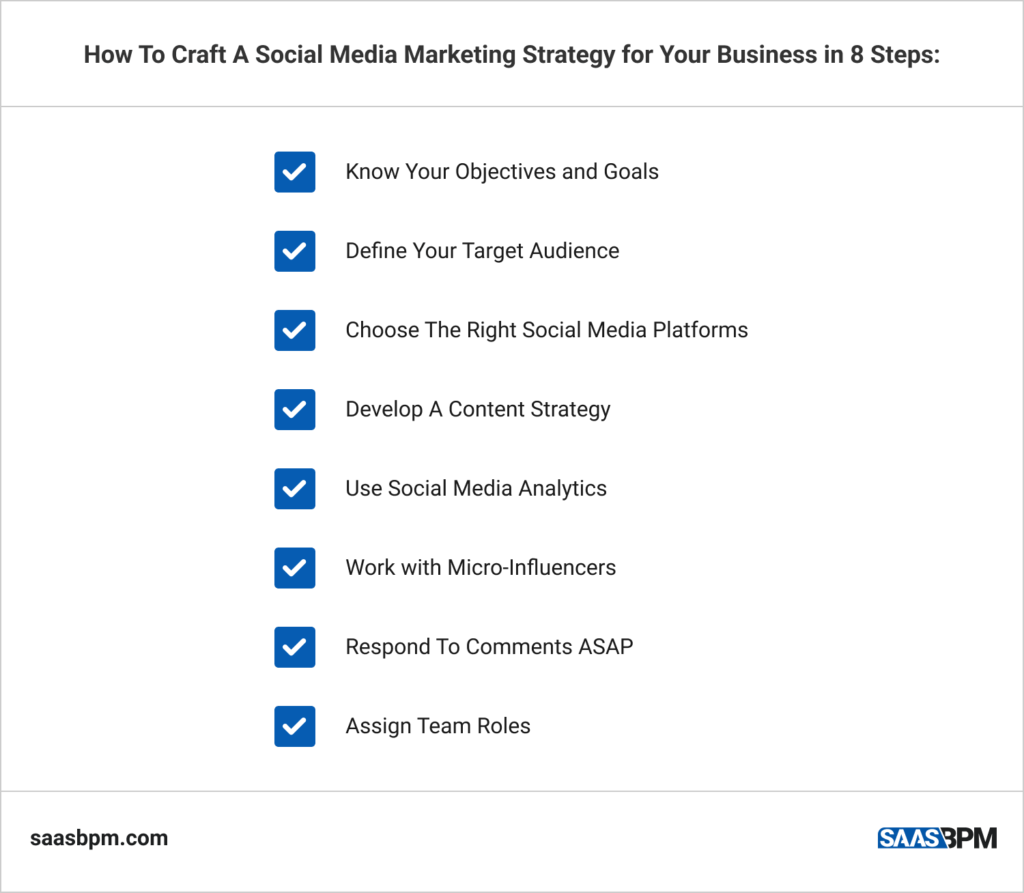If you are a business owner in 2022, you probably have already implemented social media into your marketing strategy (to at least you’ve thought about doing so!). However, as everything digital, things are moving fast with social media and you need to keep up with the newest trends to stay on top of your game and beat the competition. Whether you just want to double check if the social media marketing strategy for your business is on point, make a few tweaks here and there, or maybe even start from scratch, this guide is for you!
Do You Need A Clearly Defined Social Media Marketing Strategy for Your Business in 2022?

The short answer is: Definitely!
With over 3.96 billion active social media users (and growing!) it’s more important than ever for businesses to have a defined social media marketing strategy.
Not only will a well-executed social media strategy help you reach and engage with more customers, but it can also boost brand awareness, increase website traffic, and generate leads and sales.
What’s more, social media provides an excellent opportunity to build relationships with your customers and create a community around your brand.
It’s also worth noting that social media is no longer just a platform for sharing content – it’s now being used by consumers to research products and services, find reviews and recommendations, and make purchase decisions.
For all these reasons, businesses need to make sure they have a social media strategy that is aligned with their overall marketing goals.
Creating Your Social Media Marketing Strategy for 2022
Now that we’ve established the importance of having a social media marketing strategy for your business, let’s take a look at how you can create one yourself.

Know Your Objectives and Goals
The first step is to make sure you have a clear understanding of your overall marketing goals and objectives.
Are you looking to increase brand awareness? Drive website traffic? Generate leads or sales? Nurture relationships with customers?
Once you know your key objectives, you can start to create a social media strategy that will help you achieve them.
Define Your Target Audience
Another important step in creating your social media marketing strategy is to define your target audience.
Who are your ideal customers? What are their demographics? What are their interests and needs?
Understanding your target audience is essential because it will help you determine which social media platforms to use, what type of content to share, and how to best engage with your customers.
Choose The Right Social Media Platforms
Once you know your target audience and objectives, you can identify which social media platforms will work best for your business.
Not all social media platforms are created equal, and some will be more suited to your business than others.
For example, if you’re a B2B company, LinkedIn is likely to be a better platform for you than Snapchat. If you’re targeting millennials, Instagram might be a better choice than Facebook.
Think carefully about which platforms will allow you to reach and engage with your target audience most effectively.
Develop A Content Strategy
Once you’ve chosen your social media platforms, it’s time to start thinking about the content you’re going to share.
Your content strategy should align with your overall marketing objectives. If you’re looking to increase brand awareness, for example, you’ll need to share different content than if you’re trying to generate leads.
Also, make sure your content is tailored to the specific social media platform you’re using. What works on Instagram might not work on LinkedIn, and vice versa.
When planning your content, make sure to take into account things like quality, frequency, and format. Consistency is key – if you only post sporadically, your audience is unlikely to stick around for long.
Use Analytics To Measure Your Social Media Performance

One of the great things about social media is that it provides businesses with a wealth of data that can be used to track and measure performance.
Most social media platforms have built-in analytics tools that allow you to see how your content is performing, who your audience is, and what kind of engagement you’re getting.
This data can be extremely valuable in helping you to fine-tune your social media strategy and ensure that you’re getting the most out of your efforts.
Work With Micro-Influencers
As we’ve already established, social media is all about relationships.
One way to build and nurture relationships with your target audience is to work with micro-influencers.
Micro-influencers are social media users with a relatively small but engaged following who can help you promote your brand or product.
They are often seen as more trustworthy than celebrities or larger influencers, and their smaller follower base means they can provide more targeted reach. In fact, 67% of marketers prefer working with influencers with just 10 – 100 K subscribers.
When working with micro-influencers, it’s important to make sure they align with your brand values and that their audience is relevant to your business.
You should also give them a clear idea of what you expect from the partnership, and make sure you measure the results to see if it’s working for your business.
Respond to Comments ASAP
Remember that social media is a two-way street. It’s not enough to simply post your own content – you also need to engage with your audience.
Make sure you’re responsive to comments and questions and take the time to build relationships with the people who follow you.
The more you engage with your audience, the more likely they are to stick around – and even become brand advocates for your business.
Assign Each Task To A Team Member and Implement It In a BPM Tool
Now that you have your social media strategy in place, it’s time to start putting it into action.
Assign each task to a team member and make sure they have all the resources they need to complete it.
If possible, implement your social media strategy in a business process management tool like SaaS BPM so that you can easily track the progress on each of the steps above and fix where necessary.
Wrapping Up
By following the steps above, you’ll be well on your way to developing a social media strategy that works for your business. Just remember to be patient, measure your results, and adjust your approach as necessary. With a little time and effort, you’ll be able to build a robust social media marketing strategy for your business.

